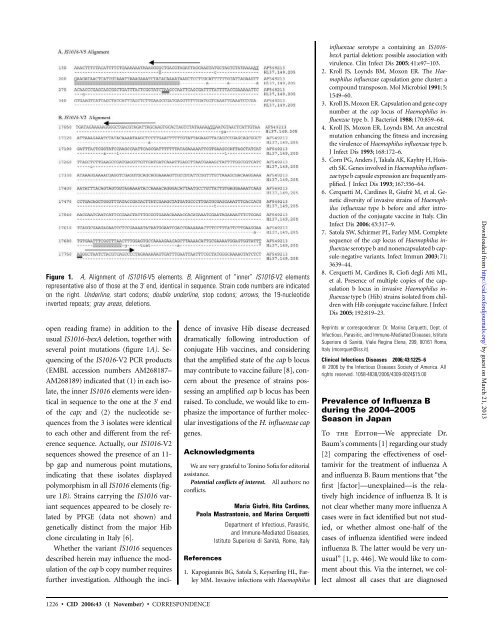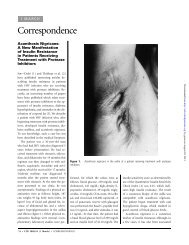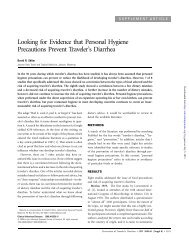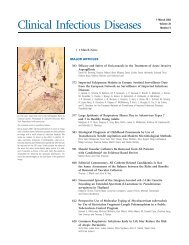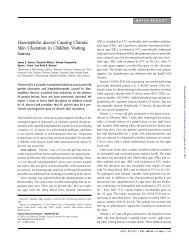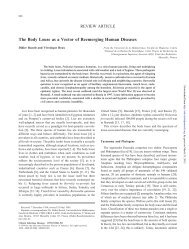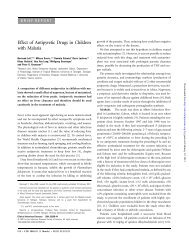open reading frame) in addition to the usual IS1016-bexA deletion ...
open reading frame) in addition to the usual IS1016-bexA deletion ...
open reading frame) in addition to the usual IS1016-bexA deletion ...
You also want an ePaper? Increase the reach of your titles
YUMPU automatically turns print PDFs into web optimized ePapers that Google loves.
Figure 1. A, Alignment of <strong>IS1016</strong>-V5 elements. B, Alignment of “<strong>in</strong>ner” <strong>IS1016</strong>-V2 elements<br />
representative also of those at <strong>the</strong> 3 ′ end, identical <strong>in</strong> sequence. Stra<strong>in</strong> code numbers are <strong>in</strong>dicated<br />
on <strong>the</strong> right. Underl<strong>in</strong>e, start codons; double underl<strong>in</strong>e, s<strong>to</strong>p codons; arrows, <strong>the</strong> 19-nucleotide<br />
<strong>in</strong>verted repeats; gray areas, <strong>deletion</strong>s.<br />
<strong>open</strong> <strong>read<strong>in</strong>g</strong> <strong>frame</strong>) <strong>in</strong> <strong>addition</strong> <strong>to</strong> <strong>the</strong><br />
<strong>usual</strong> <strong>IS1016</strong>-<strong>bexA</strong> <strong>deletion</strong>, <strong>to</strong>ge<strong>the</strong>r with<br />
several po<strong>in</strong>t mutations (figure 1A). Sequenc<strong>in</strong>g<br />
of <strong>the</strong> <strong>IS1016</strong>-V2 PCR products<br />
(EMBL accession numbers AM268187–<br />
AM268189) <strong>in</strong>dicated that (1) <strong>in</strong> each isolate,<br />
<strong>the</strong> <strong>in</strong>ner <strong>IS1016</strong> elements were identical<br />
<strong>in</strong> sequence <strong>to</strong> <strong>the</strong> one at <strong>the</strong> 3 ′ end<br />
of <strong>the</strong> cap; and (2) <strong>the</strong> nucleotide sequences<br />
from <strong>the</strong> 3 isolates were identical<br />
<strong>to</strong> each o<strong>the</strong>r and different from <strong>the</strong> reference<br />
sequence. Actually, our <strong>IS1016</strong>-V2<br />
sequences showed <strong>the</strong> presence of an 11bp<br />
gap and numerous po<strong>in</strong>t mutations,<br />
<strong>in</strong>dicat<strong>in</strong>g that <strong>the</strong>se isolates displayed<br />
polymorphism <strong>in</strong> all <strong>IS1016</strong> elements (figure<br />
1B). Stra<strong>in</strong>s carry<strong>in</strong>g <strong>the</strong> <strong>IS1016</strong> variant<br />
sequences appeared <strong>to</strong> be closely related<br />
by PFGE (data not shown) and<br />
genetically dist<strong>in</strong>ct from <strong>the</strong> major Hib<br />
clone circulat<strong>in</strong>g <strong>in</strong> Italy [6].<br />
Whe<strong>the</strong>r <strong>the</strong> variant <strong>IS1016</strong> sequences<br />
described here<strong>in</strong> may <strong>in</strong>fluence <strong>the</strong> modulation<br />
of <strong>the</strong> cap b copy number requires<br />
fur<strong>the</strong>r <strong>in</strong>vestigation. Although <strong>the</strong> <strong>in</strong>ci-<br />
1226 • CID 2006:43 (1 November) • CORRESPONDENCE<br />
dence of <strong>in</strong>vasive Hib disease decreased<br />
dramatically follow<strong>in</strong>g <strong>in</strong>troduction of<br />
conjugate Hib vacc<strong>in</strong>es, and consider<strong>in</strong>g<br />
that <strong>the</strong> amplified state of <strong>the</strong> cap b locus<br />
may contribute <strong>to</strong> vacc<strong>in</strong>e failure [8], concern<br />
about <strong>the</strong> presence of stra<strong>in</strong>s possess<strong>in</strong>g<br />
an amplified cap b locus has been<br />
raised. To conclude, we would like <strong>to</strong> emphasize<br />
<strong>the</strong> importance of fur<strong>the</strong>r molecular<br />
<strong>in</strong>vestigations of <strong>the</strong> H. <strong>in</strong>fluenzae cap<br />
genes.<br />
Acknowledgments<br />
We are very grateful <strong>to</strong> Ton<strong>in</strong>o Sofia for edi<strong>to</strong>rial<br />
assistance.<br />
Potential conflicts of <strong>in</strong>terest. All authors: no<br />
conflicts.<br />
Maria Giufrè, Rita Card<strong>in</strong>es,<br />
Paola Mastran<strong>to</strong>nio, and Mar<strong>in</strong>a Cerquetti<br />
Department of Infectious, Parasitic,<br />
and Immune-Mediated Diseases,<br />
Istitu<strong>to</strong> Superiore di Sanità, Rome, Italy<br />
References<br />
1. Kapogiannis BG, Sa<strong>to</strong>la S, Keyserl<strong>in</strong>g HL, Farley<br />
MM. Invasive <strong>in</strong>fections with Haemophilus<br />
<strong>in</strong>fluenzae serotype a conta<strong>in</strong><strong>in</strong>g an <strong>IS1016</strong><strong>bexA</strong><br />
partial <strong>deletion</strong>: possible association with<br />
virulence. Cl<strong>in</strong> Infect Dis 2005; 41:e97–103.<br />
2. Kroll JS, Loynds BM, Moxon ER. The Haemophilus<br />
<strong>in</strong>fluenzae capsulation gene cluster: a<br />
compound transposon. Mol Microbiol 1991;5:<br />
1549–60.<br />
3. Kroll JS, Moxon ER. Capsulation and gene copy<br />
number at <strong>the</strong> cap locus of Haemophilus <strong>in</strong>fluenzae<br />
type b. J Bacteriol 1988; 170:859–64.<br />
4. Kroll JS, Moxon ER, Loynds BM. An ancestral<br />
mutation enhanc<strong>in</strong>g <strong>the</strong> fitness and <strong>in</strong>creas<strong>in</strong>g<br />
<strong>the</strong> virulence of Haemophilus <strong>in</strong>fluenzae type b.<br />
J Infect Dis 1993; 168:172–6.<br />
5. Corn PG, Anders J, Takala AK, Kayhty H, Hoiseth<br />
SK. Genes <strong>in</strong>volved <strong>in</strong> Haemophilus <strong>in</strong>fluenzae<br />
type b capsule expression are frequently amplified.<br />
J Infect Dis 1993; 167:356–64.<br />
6. Cerquetti M, Card<strong>in</strong>es R, Giufrè M, et al. Genetic<br />
diversity of <strong>in</strong>vasive stra<strong>in</strong>s of Haemophilus<br />
<strong>in</strong>fluenzae type b before and after <strong>in</strong>troduction<br />
of <strong>the</strong> conjugate vacc<strong>in</strong>e <strong>in</strong> Italy. Cl<strong>in</strong><br />
Infect Dis 2006; 43:317–9.<br />
7. Sa<strong>to</strong>la SW, Schirmer PL, Farley MM. Complete<br />
sequence of <strong>the</strong> cap locus of Haemophilus <strong>in</strong>fluenzae<br />
serotype b and nonencapsulated b capsule-negative<br />
variants. Infect Immun 2003; 71:<br />
3639–44.<br />
8. Cerquetti M, Card<strong>in</strong>es R, Ciofi degli Atti ML,<br />
et al. Presence of multiple copies of <strong>the</strong> capsulation<br />
b locus <strong>in</strong> <strong>in</strong>vasive Haemophilus <strong>in</strong>fluenzae<br />
type b (Hib) stra<strong>in</strong>s isolated from children<br />
with Hib conjugate vacc<strong>in</strong>e failure. J Infect<br />
Dis 2005; 192:819–23.<br />
Repr<strong>in</strong>ts or correspondence: Dr. Mar<strong>in</strong>a Cerquetti, Dept. of<br />
Infectious, Parasitic, and Immune-Mediated Diseases, Istitu<strong>to</strong><br />
Superiore di Sanità, Viale Reg<strong>in</strong>a Elena, 299, 00161 Roma,<br />
Italy (mcerquet@iss.it).<br />
Cl<strong>in</strong>ical Infectious Diseases 2006; 43:1225–6<br />
2006 by <strong>the</strong> Infectious Diseases Society of America. All<br />
rights reserved. 1058-4838/2006/4309-0024$15.00<br />
Prevalence of Influenza B<br />
dur<strong>in</strong>g <strong>the</strong> 2004–2005<br />
Season <strong>in</strong> Japan<br />
To <strong>the</strong> Edi<strong>to</strong>r—We appreciate Dr.<br />
Baum’s comments [1] regard<strong>in</strong>g our study<br />
[2] compar<strong>in</strong>g <strong>the</strong> effectiveness of oseltamivir<br />
for <strong>the</strong> treatment of <strong>in</strong>fluenza A<br />
and <strong>in</strong>fluenza B. Baum mentions that “<strong>the</strong><br />
first [fac<strong>to</strong>r]—unexpla<strong>in</strong>ed—is <strong>the</strong> relatively<br />
high <strong>in</strong>cidence of <strong>in</strong>fluenza B. It is<br />
not clear whe<strong>the</strong>r many more <strong>in</strong>fluenza A<br />
cases were <strong>in</strong> fact identified but not studied,<br />
or whe<strong>the</strong>r almost one-half of <strong>the</strong><br />
cases of <strong>in</strong>fluenza identified were <strong>in</strong>deed<br />
<strong>in</strong>fluenza B. The latter would be very un<strong>usual</strong>”<br />
[1, p. 446]. We would like <strong>to</strong> comment<br />
about this. Via <strong>the</strong> <strong>in</strong>ternet, we collect<br />
almost all cases that are diagnosed<br />
Downloaded from<br />
http://cid.oxfordjournals.org/ by guest on March 21, 2013
Figure 1. The number of patients <strong>in</strong> each season surveyed by <strong>the</strong> date of onset of <strong>in</strong>fluenza A<br />
or <strong>in</strong>fluenza B. Percentages are <strong>the</strong> percentage of all seasonal cases of <strong>in</strong>fluenza attributable <strong>to</strong><br />
<strong>in</strong>fluenza B. Median, median date of epidemic, expressed as month/day.<br />
with use of <strong>the</strong> commercial rapid detection<br />
kits <strong>in</strong> <strong>the</strong> participat<strong>in</strong>g cl<strong>in</strong>ics throughout<br />
Japan between 10 November and 31 May<br />
every year. Figure 1 shows <strong>the</strong> date of onset<br />
and <strong>the</strong> number of cases of <strong>in</strong>fluenza A<br />
or <strong>in</strong>fluenza B that were diagnosed with<br />
<strong>the</strong> use of rapid detection kits dur<strong>in</strong>g <strong>the</strong><br />
past 5 <strong>in</strong>fluenza seasons. The <strong>to</strong>tal number<br />
of <strong>in</strong>fluenza A or <strong>in</strong>fluenza B cases, <strong>the</strong><br />
percentage of cases that are attributable <strong>to</strong><br />
<strong>in</strong>fluenza B, and <strong>the</strong> median date of <strong>the</strong><br />
epidemic <strong>in</strong> each season are also shown.<br />
The prevalence of <strong>in</strong>fluenza A was consistent<br />
<strong>in</strong> almost every year. However, <strong>the</strong><br />
prevalence of <strong>in</strong>fluenza B was variable season<br />
by season. The percentage of <strong>in</strong>fluenza<br />
cases attributable <strong>to</strong> <strong>in</strong>fluenza B was very<br />
small <strong>in</strong> <strong>the</strong> 2003–2004 and 2005–2006<br />
seasons (2.5% and 2.1%, respectively).<br />
However, <strong>in</strong> <strong>the</strong> 2004–2005 season, <strong>the</strong><br />
number of <strong>in</strong>fluenza B cases was more<br />
than twice <strong>the</strong> number of <strong>in</strong>fluenza A<br />
cases; <strong>the</strong> percentage of <strong>in</strong>fluenza cases attributable<br />
<strong>to</strong> <strong>in</strong>fluenza B was 67.8%. The<br />
high <strong>in</strong>cidence of <strong>in</strong>fluenza B dur<strong>in</strong>g <strong>the</strong><br />
2004–2005 season <strong>in</strong> Japan (also available<br />
on <strong>the</strong> Web site of <strong>the</strong> Infectious Disease<br />
Surveillance Center of Japan [3]) seemed<br />
<strong>to</strong> be un<strong>usual</strong>, as mentioned by Baum [1].<br />
We would also like <strong>to</strong> emphasize that<br />
all patients from whom we obta<strong>in</strong>ed <strong>the</strong><br />
date and time of <strong>the</strong> onset of fever, <strong>the</strong><br />
adm<strong>in</strong>istration of oseltamivir, and <strong>the</strong> resolution<br />
of fever were <strong>in</strong>cluded <strong>in</strong> <strong>the</strong> study,<br />
and no patients with <strong>in</strong>fluenza A or <strong>in</strong>fluenza<br />
B from whom we obta<strong>in</strong>ed <strong>the</strong>se data<br />
were excluded [2].<br />
In <strong>the</strong> 2004–2005 season, <strong>in</strong>fluenza A<br />
and <strong>in</strong>fluenza B were almost simultaneously<br />
prevalent (<strong>the</strong> median dates of <strong>the</strong><br />
epidemics were 27 February for <strong>in</strong>fluenza<br />
A and 21 February for <strong>in</strong>fluenza B). It<br />
seems <strong>to</strong> be important <strong>to</strong> differentiate patients<br />
with <strong>in</strong>fluenza A from patients with<br />
<strong>in</strong>fluenza B by use of commercial antigen<br />
detection kits, particularly dur<strong>in</strong>g seasons<br />
<strong>in</strong> which both types of <strong>in</strong>fluenza virus are<br />
simultaneously prevalent (such as <strong>the</strong><br />
2004–2005 season), because oseltamivir is<br />
less effective for <strong>the</strong> treatment of <strong>in</strong>fluenza<br />
B virus, as reported elsewhere [2, 4].<br />
Acknowledgments<br />
Potential conflicts of <strong>in</strong>terest. All authors: no<br />
conflicts.<br />
Naoki Kawai, 1 Hideyuki Ikematsu, 1,2<br />
Norio Iwaki, 1 Nobuo Hirotsu, 1 and<br />
Seizaburo Kashiwagi3 1Japan Physicians Association, Tokyo, and<br />
2<br />
Department of Cl<strong>in</strong>ical research, Hara-doi Hospital,<br />
and 3 Fukuoka Red Cross Blood Center,<br />
Fukuoka, Japan<br />
References<br />
1. Baum SG. Oseltamivir and <strong>the</strong> <strong>in</strong>fluenza alphabet.<br />
Cl<strong>in</strong> Infect Dis 2006; 43:445–6.<br />
2. Kawai N, Ikematsu H, Iwaki N, et al. A comparison<br />
of <strong>the</strong> effectiveness of oseltamivir for<br />
<strong>the</strong> treatment of <strong>in</strong>fluenza A and <strong>in</strong>fluenza B:<br />
a Japanese multicenter study of <strong>the</strong> 2003–2004<br />
and 2004–2005 <strong>in</strong>fluenza seasons. Cl<strong>in</strong> Infect<br />
Dis 2006; 43:439–44.<br />
3. Infectious Disease Surveillance Center of Japan.<br />
Weekly reports of virus isolation/detection<br />
2002/03–2006/07. Available at: https://hassei<br />
doko.mhlw.go.jp/Byogentai/Pdf/data2e.pdf.<br />
Accessed 20 September 2006.<br />
4. Kawai N, Ikematsu H, Iwaki N, et al. Fac<strong>to</strong>rs<br />
<strong>in</strong>fluenc<strong>in</strong>g <strong>the</strong> effectiveness of oseltamivir and<br />
amantad<strong>in</strong>e for <strong>the</strong> treatment of <strong>in</strong>fluenza: a<br />
CORRESPONDENCE • CID 2006:43 (1 November) • 1227<br />
Downloaded from<br />
http://cid.oxfordjournals.org/ by guest on March 21, 2013
multicenter study from Japan of <strong>the</strong> 2002–2003<br />
<strong>in</strong>fluenza season. Cl<strong>in</strong> Infect Dis 2005; 40:<br />
1309–16.<br />
Repr<strong>in</strong>ts or correspondence: Dr. Naoki Kawai, 4-9 Tonomachi,<br />
Gifu City, 500-8116, Japan (nkawai@city.gifu.med.or.jp).<br />
Cl<strong>in</strong>ical Infectious Diseases 2006; 43:1226–8<br />
2006 by <strong>the</strong> Infectious Diseases Society of America. All<br />
rights reserved. 1058-4838/2006/4309-0025$15.00<br />
In Support of Dr. Thomas<br />
Butler<br />
To <strong>the</strong> Edi<strong>to</strong>r—We would like <strong>to</strong> thank<br />
Greenough [1] for his update on Dr.<br />
Thomas Butler. It is important that young<br />
physicians rema<strong>in</strong> aware of <strong>the</strong> pitfalls that<br />
exist with<strong>in</strong> <strong>the</strong> field of <strong>in</strong>fectious diseases<br />
and with<strong>in</strong> <strong>the</strong> academic environment. We<br />
are sure that all of us will now pause for<br />
a moment before we transport microbiologic<br />
agents, sign a contract with an academic<br />
<strong>in</strong>stitution, or report a miss<strong>in</strong>g<br />
specimen. To not pause would be foolish;<br />
<strong>the</strong> personal risks are <strong>to</strong>o great. However,<br />
as each of you realize, it will take far more<br />
than a moment’s pause <strong>to</strong> assure adherence<br />
<strong>to</strong> new standards, and as Relman et<br />
al. [2] state, <strong>the</strong> losers will be life sciences<br />
research and <strong>the</strong> biodefense effort.<br />
One would hope that Tom’s horrendous<br />
experience will help o<strong>the</strong>rs <strong>to</strong> avoid<br />
<strong>the</strong> “woods” that <strong>in</strong>carcerated him and<br />
robbed him of his precious medical license<br />
and career. We hope that some person who<br />
reads about his plight will f<strong>in</strong>d a niche that<br />
will provide emotional and f<strong>in</strong>ancial relief<br />
<strong>to</strong> this dedicated scientist.<br />
We met Tom <strong>in</strong> Vietnam <strong>in</strong> 1974 while<br />
he was conduct<strong>in</strong>g research on plague and<br />
diarrheal diseases. We knew him <strong>to</strong> be an<br />
enthusiastic and diligent researcher. We<br />
were particularly encouraged <strong>to</strong> read<br />
Tom’s words and <strong>to</strong> see that he has been<br />
able <strong>to</strong> f<strong>in</strong>d employment. We are sure that<br />
his reunion with family and friends will<br />
go a long way <strong>in</strong> help<strong>in</strong>g him <strong>to</strong> heal.<br />
Although Tom and family have led a frugal<br />
existence, <strong>the</strong>y cont<strong>in</strong>ue <strong>to</strong> have tremendous<br />
debts and <strong>to</strong> face <strong>the</strong> challenges<br />
of day-<strong>to</strong>-day life.<br />
We <strong>in</strong> <strong>the</strong> Infectious Diseases Society of<br />
America should reach out <strong>to</strong> Tom and his<br />
family with generous support, <strong>to</strong> help him<br />
1228 • CID 2006:43 (1 November) • CORRESPONDENCE<br />
overcome some of his legal debts. We<br />
would encourage all who can afford a donation<br />
<strong>to</strong> send it directly <strong>to</strong> Tom:<br />
Thomas Butler, M.D.<br />
4611 10th St.<br />
Lubbock, TX 79416<br />
Acknowledgments<br />
Potential conflicts of <strong>in</strong>terest. K.G and J.D.B:<br />
no conflicts.<br />
Kenneth Gould1,a and Joel D. Brown 2<br />
1Sou<strong>the</strong>rn California Kaiser Permanente Medical<br />
Group, California; and 2 Department of Internal<br />
Medic<strong>in</strong>e, University of Hawaii John A. Burns<br />
School of Medic<strong>in</strong>e, Honolulu<br />
References<br />
1. Greenough WB. Update on Dr. Thomas Butler.<br />
Cl<strong>in</strong> Infect Dis 2006; 43:259–60.<br />
2. Rellman DA, Choff<strong>in</strong>es E, Lemon SM. In search<br />
of biosecurity. Science 2006; 311:1835.<br />
a Retired.<br />
Repr<strong>in</strong>ts or correspondence: Dr. Kenneth Gould (kennethgould<br />
@comcast.net).<br />
Cl<strong>in</strong>ical Infectious Diseases 2006; 43:1228<br />
2006 by <strong>the</strong> Infectious Diseases Society of America. All<br />
rights reserved. 1058-4838/2006/4309-0026$15.00<br />
Downloaded from<br />
http://cid.oxfordjournals.org/ by guest on March 21, 2013


